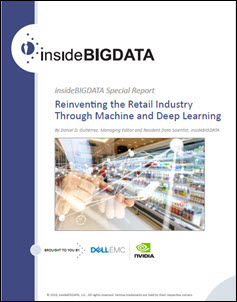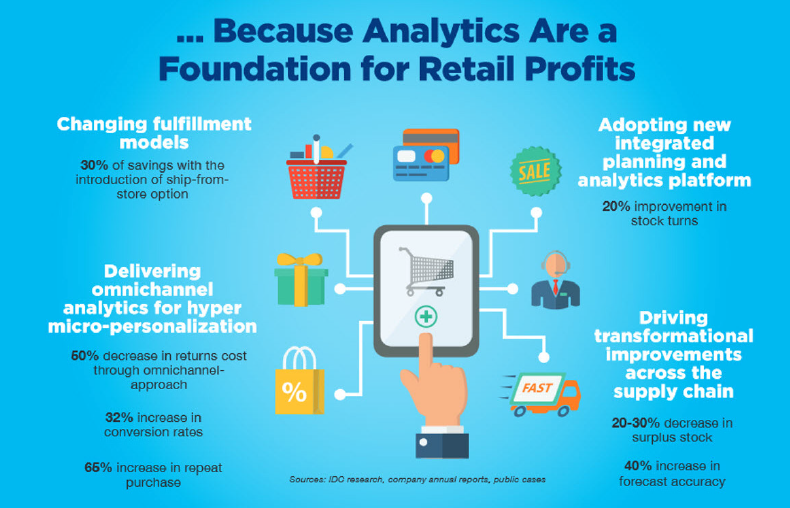 The insideBIGDATA Special Report: Reinventing the Retail Industry through Machine and Deep Learning white paper explores how AI, machine learning and deep learning are transforming the retail industry in many positive directions including:
The insideBIGDATA Special Report: Reinventing the Retail Industry through Machine and Deep Learning white paper explores how AI, machine learning and deep learning are transforming the retail industry in many positive directions including:
- Inventory and supply chain management
- Analysis of customer buying patterns
- Analyzing traffic patterns
- Providing assortment planning
- Performing retail analytics at scale
- Fighting cyberfraud
Analyzing Buying Patterns
Another important area where the retail industry is taking advantage of machine learning is in analyzing buying trends and patterns to identify and prepare for personalized digital cross-sell and upsell opportunities—showing customers the most relevant products based on their behavior at that moment. Further, technology can help prevent customers from abandoning a retailer’s website by sensing the first signs they might drop off and causing live chat assistance windows to pop-up.
Given the capabilities of AI and machine learning, it’s easy to see how they can be powerful tools for retailers—reading and listening to data, understanding and learning from it, and instantly and accurately recommending the next best action without needing to be explicitly programmed. This is a boon for retailers seeking to accurately predict demand, anticipate customer behavior, and optimize and personalize customer experiences. For example, it can be used to automate:
- Personalized product recommendations based on data about each customer’s unique interests and buying propensity;
- The selection of additional upsell and cross-sell options that drive greater customer value;
- Chat bots that can drive intelligent and meaningful engagement with customers;
- Recommendations on additional services and offerings based on past and current buying data and customer data;
- Planogram analyses, which support in-store merchandizing by telling people what’s missing, comparing sales to shelf space, and accelerating shelf replenishment by automating reorders;
- Pricing engines used to make tailored, situational pricing decisions.
Retailers are able to collect large volumes of transaction-based and behavioral data from their customers. And, as data volumes grow and processing power improves, machine learning becomes increasingly applicable in a wider range of retail areas to further optimize business processes and drive more impactful personalized and contextual consumer experiences and products.

How Retail Analytics is shaping Retails Future, courtesy of SAP
Analyzing Traffic Patterns
Yet another important area of technology being cultivated by retailers is the use of deep learning for predicting retail foot traffic trends. Using sensors can detect in-store foot traffic by combining video and audio from real-time traffic along with mobile fingerprinting from shoppers’ smartphones.
Consumer behavior coupled with location data offers unique insights that are built on an understanding of billions of anonymous location-enabled daily device movements, and used by brands for sophisticated consumer analytics and insights in a retail setting. These insights are foundational to a wide range of business decisions, including advertising strategy and planning, customer segmentation, merchandising, product development, and investment strategy.
A typical deep learning scenario for predicting retail foot traffic is as follows: use a series of neural networks along with retailer traffic data; make a prediction and check accuracy; if predicted vs. actual is divergent use a process called “back propagation” to go back through all the steps, make adjustments, and adjust weights to achieve a more accurate result the next time around; repeat the process many times, and each time the system gets a bit smarter about how to predict traffic.
Thanks to technologies like deep learning, retail foot traffic counting and analysis has taken significant strides. Some vendor solutions perform deep learning that enables us to better estimate traffic. In doing so, the industry is leveraging two specific components of modern deep learning that are critical to success: access to extremely large training data sets, and newly available compute resources using GPUs. We’re now able to crunch data sets at a rate that was impossible just a few years ago using techniques that go far beyond the basic statistics and linear regressions of the past. These statistical techniques are nodes within a hierarchy of neural networks, and they allow us to quickly test and tweak our programs by using cutting-edge deep learning maneuvers.
[clickToTweet tweet=”Special Report: Reinventing Retail Industry through ML and DL explores how the retail industry is being transformed.” quote=”The insideBIGDATA Special Report: Reinventing the Retail Industry through Machine and Deep Learning white paper explores how AI, machine learning and deep learning are transforming the retail industry in many positive directions.”]
Assortment Planning
Retailers frequently struggle with assortment planning and allocation optimization to ensure the right product is delivered to the right store in time for expected consumer demand. Assortment planning addresses the fundamental condition of what items will be available for sale. Effective assortment planning ensures that the right mix and range of retail goods are in stock for customers in every channel and category.
With deep learning, a statistical model can predict consumer demand to ensure inventory movement is directed to the right distribution center or store. Many organizations solve this problem with a batch-oriented allocation process that delays real-time analysis and takes time to resolve for impatient consumers, or they have relied strictly on traditional CPU’s that have low turnaround times.
With a trained model built on item, store, and consumer demand, machine learning becomes an engine that can optimize assortments, supply chain routes, as well as feed an engine for targeted promotions and consumer-specific recommendations.
Article Series
In a series of articles over the next few weeks we will explore these topics:
- Introduction, Intelligent retail inventory management
- Analyzing buying patterns, analyzing traffic patterns, assortment planning
- Retail analytics at scale, Deep learning for maintaining privacy and combating fraud
- Dell EMC machine learning and deep learning ready bundles, summary
If you prefer, the complete insideBIGDATA Special Report: Reinventing the Retail Industry through Machine and Deep Learning is available for download in PDF from the insideBIGDATA White Paper Library, courtesy of Dell EMC and NVIDIA.




Speak Your Mind